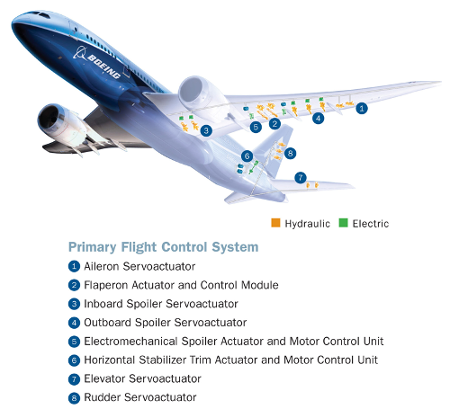Russian scientists have developed a matrix of active actuators against turbulence for the wing of the aircraft

Smart electromechanical and electro-hydraulic actuators with integrated electronics on the Boeing 787-8 control 21 aerodynamic flight control surfaces. Manufacturer: Moog Inc.
Scientists of the St. Petersburg State University and the Institute of Problems of Mechanical Engineering of the Russian Academy of Sciences with the support of the Russian Science Foundation have developed an innovative way to combat turbulence in aviation - a system of active plates on the wing of an aircraft that independently change their spatial position depending on air pressure, Izvestia writes .
The developers propose to cover the surface of the wing with a matrix of active cells, each of which is equipped with a pressure sensor, a microcomputer and a wing plate - with a pen, - with an electric drive. When turbulence occurs, “feathers” set in motion and change their inclination relative to the wing, compensating for the resulting air pressure non-uniformity. In this case, each "pen" communicates with neighboring cells, calculating the required position.
In a sense, scientists have spotted such a decision from nature. In sharks, killer whales, dolphins and other large marine animals, when swimming at high speed, the skin surface vibrates, which prevents movement from becoming turbulent.
')
Turbulence is a phenomenon observed in many flows of liquids and gases, which consists in the fact that numerous vortices of various sizes are formed in these flows, as a result of which their hydrodynamic and thermodynamic characteristics (speed, pressure, temperature, density) experience random fluctuations and therefore change over time. and space is irregular.
The problem with turbulence is that it significantly increases the amount of energy needed for body movement. If at low speeds the resistance increases in proportion to the speed, but after a certain critical value of the Reynolds number is exceeded, turbulent turbulence begins to form. From this point on, resistance grows in proportion to the square of the speed. Even a slight increase in speed requires a lot of energy.
The study of dolphins in the hydrodynamic tube showed that during the movement the flow of fluid around the dolphin remains laminar, that is, no turbulent flows arise. As it turned out, when moving in the water on the thick elastic skin of the dolphin run through the folds. They occur exactly at those moments when the surrounding flow is about to turn from laminar to turbulent. It is at this moment that a “traveling wave” arises on the skin, which quenches the resulting turbulence. According to scientists, dolphins reach speeds of up to 54 km / h, after which they turn on the pain threshold.
Engineers subsequently began to repeat this biological mechanism in shipbuilding, aircraft manufacturing, during the construction of oil pipelines, etc. However, active actuators on the wings under the control of microcomputers are a fundamentally new level of development.
“We are not at all trying to eliminate turbulence as such, and this is impossible,” explained the project manager, doctor of physical and mathematical sciences, professor at St. Petersburg State University Oleg Granichin. “We set ourselves another task: to compensate for the difference in pressure in different zones of the wing so that the aircraft remains stable in the zone of turbulence.”
A mathematical solution to the project was developed at SPbU. The authors of the system say that a solution with a distributed control system was forced: “For centralized management of all cells, even the most powerful modern computer would not have enough speed,” said Konstantin Amelin, postdoc developer of the St. Petersburg State University.
The system has already been tested in practice. An experiment in a wind tunnel on a meter wing with a hundred “feathers” showed that the distributed system of microcomputers (Konstantin Amelin for some reason compares it with the blockchain) works in concert and finds a consensus solution for each unit of feathers. Now engineers are working to create a more sophisticated test bench with a working model of the aircraft, whose wing span is already two meters, and the “feathers” can rotate in two planes, and not in one, as now.
Independent experts carefully evaluate the work of colleagues. The fact is that active actuators are far from a new idea. Scientists have experienced a variety of technological solutions, but so far no one has proposed a ready-made solution that would compensate for turbulence at high speed, and not only in a narrow range of speeds.
Source: https://habr.com/ru/post/374351/
All Articles